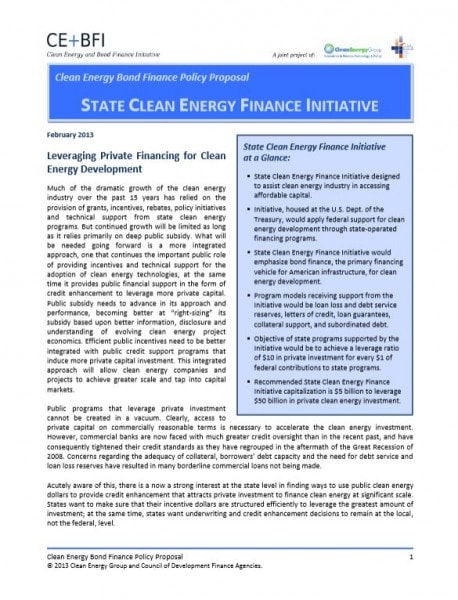February 11, 2013
State Clean Energy Finance Initiative – A New Federalist Approach to Boost Clean Energy Investment
By Lewis Milford

The unique aspect of this proposal – called the State Clean Energy Finance Initiative (SCEFI) – is that it puts the funding responsibility and accountability at the state level, where all states could use these funds in the best way they know how, instead of having the federal government make funding decisions on investments in clean energy projects and companies. Clean Energy Group has developed this proposal with our partner the Council of Development Finance Agencies (see www.cebfi.org).
While this approach is somewhat new in clean energy, it is based on an existing federal program already in place for small business, run by the Treasury Department. It is called the State Small Business Credit Initiative or SSBCI, which now distributes $1.5 billion to the states. SSBCI, like our proposal, has a requirement to match those funds with other public and private capital but leaves much discretion to the states to create finance vehicles. Our SCEFI model would follow this capital match, and allow states to continue to be clean energy leaders, and to create new financial instruments to suit their state and local needs.
This simple and powerful leverage requirement would be an efficient means of attracting significant private investment to clean energy, and keep investment decisions at the state and local levels, rather than in Washington. It would be a way for states to support new investment instruments like bonds, which are needed to raise capital for the clean energy industry. State could create pooled bond funds and small issue bonds for manufacturers in the clean energy supply chain. By mitigating risk for investors, credit enhancement would raise more capital more efficiently at lower cost to multiple energy projects.
This leverage requirement also recognizes that while continued public support for clean energy in the form of state and other incentives is needed for some time, it must be designed to better leverage private capital. When lenders are reluctant to lend on favorable terms, credit enhancement can be used to reduce credit risk by providing collateral accounts, guarantees or other inducements that reassure the lender that it will be compensated if the borrower defaulted.
Put another way, public subsidy for clean energy will be important for some time to come, but it needs to be “right-sized” so it is better integrated with public credit support programs that induce more private capital investment. This integrated approach will allow clean energy companies and projects to achieve greater scale and tap into capital markets. This is especially needed now, because bank lending is still difficult to access as financial markets continue their recovery from the great recession. There is a strong need to provide more credit enhancement or debt to projects and companies in the clean energy space.
Also, as the clean energy sector matures, it is important to look for other federal agencies to take leadership roles. That is why we propose this program be run by the Treasury Department, which runs the SSBCI program. We believe it is time to take the experience from this SSBCI model and apply it to clean energy—to extend the SSBCI model to help address the capital access challenges confronting clean energy.
And although the program would be housed in Treasury, the underwriting and credit enhancement roles would be placed at the state and local levels where these roles belong. Treasury would develop guidelines defining various structuring factors to a manageable toolbox of program structures, and Treasury would approve each state’s clean energy credit support programs. Each state would have the right to select only the programs it wants to operate.
Establishing a financing-based model to bolster this sector would encourage the development of clean energy at a time when direct appropriations to the industry are facing increased pressure. An SSBCI-like model should be applied to clean energy supply chain companies needing financing for working capital, equipment, real estate acquisition or improvements to their business premises, as well as to project financings of on-site and district clean energy generation limited to eligible technologies size limitations.
Importantly, SCEFI would not create any federal guaranty or obligation regarding the state-financed projects. The limits of the federal role would be to provide credit enhancement dollars to state financing programs and create guidelines for program success.
Although any funding limit would need to be set by Congress at a fixed level, by appropriating $5 billion in funding for clean energy credit support, the proposed program could leverage an additional $50 billion of private and other capital for companies and projects in every state in the nation, requiring little if any additional federal administrative burden. SCEFI is at the concept stage, representing a smarter form of federal support for clean energy.
The details of such proposal, including funding levels, administrative details and guidelines, must be developed. CEG and CDFA are proposing this recommendation now in the hopes of garnering public and governmental support for such a new effort.














